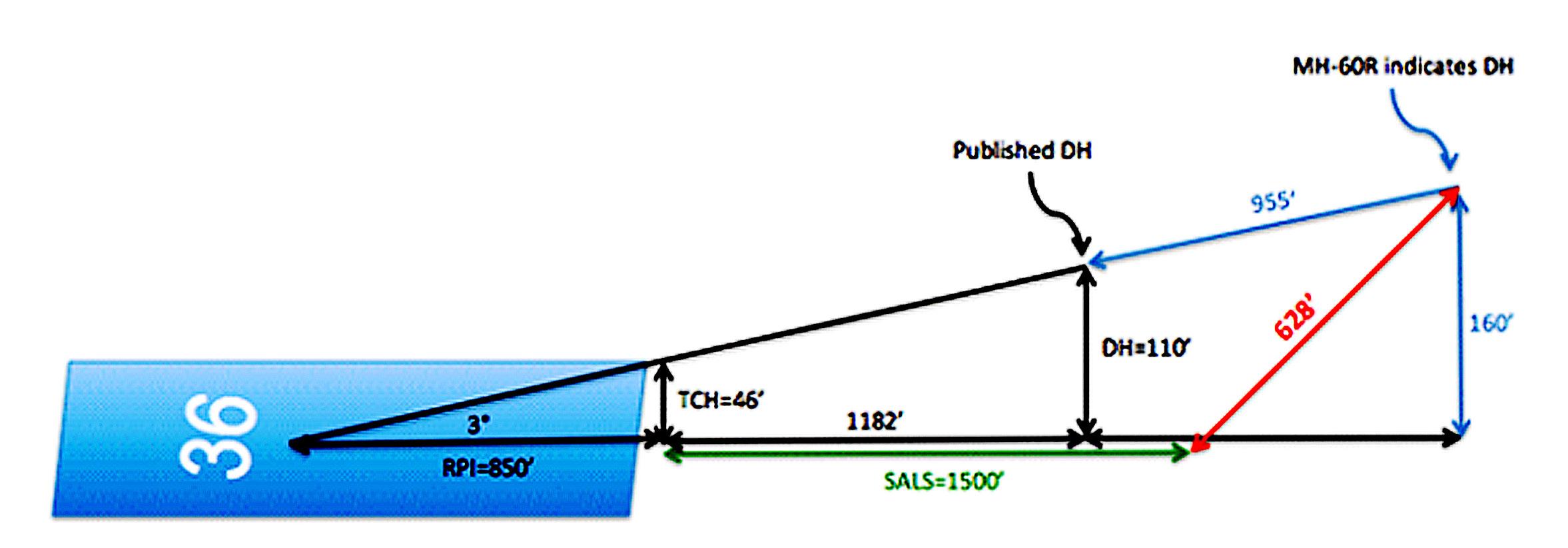
8 minute read
The Not-So-Precision Approach
BY LT DAVID FARRELL
In aviation, accurately knowing aircraft altitude is paramount. Most aircraft measure altitude using two sensors. The radar altimeter (RADALT) electronically measures the aircraft height above the ground (or sea) by measuring the round trip timing of radio waves from the aircraft to the ground and back. The barometric altimeter (BARALT) uses the static pressure measured by the aircraft’s static port(s) to quantify the aircraft’s altitude above mean sea level. If all else is equal, the BARALT and RADALT should both indicate the same altitude when flying over the ocean. However, throughout hundreds of flights that I have flown as an MH-60R instructor pilot, consistent discrepancies existed between the BARALT and RADALT in each aircraft I have flown.
Altimeter-Setting Error
Pilots use the local altimeter setting (based upon atmospheric pressure variation) for calibration prior to flight. On deck, calibrating the BARALT to the local altimeter setting is supposed to cause the BARALT to indicate the airfield elevation within plus or minus 75 feet. If it doesn’t, the accuracy of the altimeter is questionable, and the device must be repaired. Even more restrictively, the MH-60R integrated electronic technical manuals (IETMs) dictate an error limit of plus or minus 60 feet before maintenance action is required on the BARALT.
In my experience, the MH-60R BARALT consistently indicates within plus or minus 10 feet of the correct elevation on deck, well within the limit dictated by the AIM or IETMs.
This is not the case, however, in forward flight. When flying at mid-range airspeeds (50-100 knots indicated airspeed, KIAS) often used for instrument approaches, the MH-60R BARALT indicates 40-to60 feet (nominally 50 feet) lower than it should. For example, in level flight over the ocean at 90 KIAS and with 200 feet indicated on the RADALT, the BARALT will indicate a mere 150 feet if calibrated to the local altimeter setting. However, neither the AIM nor the IETMs dictates an allowable BARALT error limit in flight because they assume a similar error on deck and in flight. In the MH-60R at least, this assumption does

Photo by Mass Communication Specialist Seaman Apprentice Tyler Caswell
not hold true.
Source of the Error
The exact cause of this error is unclear, but basic knowledge of the BARALT’s pitot-static system tells us that the static port of the BARALT system must be experiencing an artificially high local pressure compared to the co-altitude ambient air pressure. It is likely this error was present in older H-60 models with the same physical pitot-static system (SH-60B, SH-60F and HH-60H to name a few), but has only recently been observable due to the discrete, digital readout of altitude in a glass cockpit. Note that the MH-60R and MH-60S have different pitot-static systems; this article only describes an error in the MH-60R’s system.
The MH-60R’s Not-So-Precision Approach
During a precision instrument approach, a 50-foot altitude error is not negligible. For example, on a typical precision instrument approach with a 3 degree glideslope and published decision height (DH) of 200 feet, a 50-foot error in the pilot’s altitude indication raises the ceiling requirement to successfully conduct the approach by 25 percent, and the visibility requirement by nearly 40 percent. But that is not all. To fully understand the implication of this BARALT error, one must also consider runway approach lighting. Actual instrument approaches are flown when instrument meteorological conditions (IMC) prevail. At night and during IMC, airfields turn on runway approach lights to
help pilots visually acquire the landing environment before the aircraft ever reaches the runway’s landing threshold. Let’s examine the affects of the MH-60R’s known BARALT error on the ability of a pilot to visually acquire the runway approach lighting when conducting a precision instrument approach to one of the Navy’s busiest airports: the precision approach radar (PAR) to runway 36 at Naval Air Station North Island (KNZY). Figure 1 shows that a pilot conducting this instrument approach may never see the runway or its approach lighting when 200 feet is indicated in the cockpit. The MH-60R is nearly twice as far from the runway and almost six times further from the approach lighting as intended by the FAA-approved instrument approach procedure. “Precision” is loose term Aviation Electronics Technician Airman Apprentice Zachary Hoying for such an approach.
checks the low altitude warning light on a radar altimeter indicator. The Good News
First, the opposite error would be much worse. If the BARALT consistently indicated higher than the RADALT, then pilots using the BARALT as their primary altitude instrument would think they had more clearance from the terrain below than they actually do. Such an error could result in controlled flight into terrain (CFIT). Second, the instrument approach procedures to ships do not rely on the BARALT. The MH-60R NATOPS flight manual explains that the RADALT, not the BARALT, should be the primary altitude instrument when flying an instrument approach to a ship. This procedure already mitigates the effects of inaccurate information from the BARALT. Most other naval aircraft also use their RADALT primarily during approaches to naval vessels. Third, the error has less effect on TACAN approaches. During a tactical air navigation (TACAN) “non-precision” instrument approach (used during instrument approaches to Navy vessels and military airfields) the BARALT error only results in elevation inaccuracy, not horizontal distance error. Horizontal distance during a TACAN approach is measured by distance measuring equipment (DME), which is not susceptible to the BARALT error described above.
The Bad News
First, MH-60R pilots must learn to manage their BARALT error. An in-flight technique used over the ocean to instantaneously synchronize the BARALT to the RADALT is called a ”BARO SYNC”. This works
well in the specific situation of over-ocean flight, but pilots must keep in mind that doing so changes the altimeter setting of their BARALT in order to match the RADALT. Over the ocean, which altimeter setting should a pilot use? The local altimeter setting previously calibrated on deck? Or the one that indicates the correct altitude in flight? This difference can be significant. It is nominally 0.05 inches Hg, corresponding to 50 feet in elevation.
Second, DH/MDA determination is no longer black & white. During any PAR if the runway environment is not in sight when the pilot BARALT indicates the DH, should the pilot wave off immediately or wait to make the decision until the approach controller verbalizes “at decision height?” During a typical 90 KIAS instrument approach, the amount of time between the BARALT indicating the DH, and the approach controller verbalizing “at decision height” is about six seconds, or nearly one-fourth of a mile of aircraft travel. Would waiting until the approach controller verbalized “at decision height” violate OPNAVINST 3710.7U section 5.3.5.4, since it prohibits descent below the DH/minimum descent altitude (MDA) unless the runway environment is in sight and in the pilots judgment a safe landing can be made?
Would a pilot violate the same OPNAVINST 3710.7U section if they descended 50 feet below the MDA during an over-land TACAN approach to “correct” for the BARALT error? I would never advocate violating OPNAVINST 3710.7U, but the knowledge of this BARALT error puts pilots in a dilemma that needs discussion both inside and outside of the MH-60R community.Third, flight simulators do not replicate this error. The BARALT error is only observed in the MH-60R aircraft itself. Aviators governed by OPNAVINST 3710.7U know section 13.2.1.f well, which states, “approved flight simulators… may be utilized to meet one-half of the minimum instrument rating requirements.” Therefore, pilots could become desensitized to the necessity of managing their altimeter setting in the aircraft because (up to) half of their instrument training each year is in a flight simulator.
A Small Error with Big Implications
Although the aerodynamic explanation for this BARALT error in the MH-60R remains unclear, it is essential for all MH-60R pilots to observe its existence and consider strategies to mitigate its effects. A robust discussion is needed amongst MH-60R pilots to consider the legality and risk versus reward of determining a DH or MDA with any method other than a BARALT calibrated to the local altimeter setting. Further, it is important for pilots of all instrument-rated aircraft to observe if the aircraft they fly is susceptible to any consistent BARALT errors. The implications of what may seem like a small BARALT error can have a very large Effect on safety of flight.
LT FARRELL FLIES WITH HSM-41

The PAR approach at KNZY has a published DH of 110 feet, a threshold crossing height (TCH) of 46 feet, and a runway point of intercept (RPI) of 850 feet. It uses a 3° glideslope. The runway has a short approach lighting system (SALS) installed, extending 1500 feet prior to the runway threshold. The published DH is located 1182 feet from the runway threshold, more than 300 feet into the SALS (shown in green). At the published DH, the straight-line distance of the aircraft to the SALS is simply the height of the aircraft above the ground (110 feet). However, in the MH-60R, a pilot indicates that they’ve reached the DH nearly 955 feet from the published DH and 160 feet above the ground (shown in blue), at a distance of 628 feet from the closest approach lighting (shown in red).
“OVERALL, ENSURE THAT COMMUNICATION FLOWS BETWEEN
PILOTS, AIRCREW, AND MISSION PLANNERS TO ENSURE THAT WE FLY OUR AIRCRAFT SAFELY AND TO THEIR MAXIMUM PERFORMANCE WITHOUT ACCEPTING UNNECESSARY RISK THAT WE BRING ON OURSELVES. OUR MODUS OPERANDI IS ‘FLY, FIGHT, WIN.’”
— LTJG Robert Kaplan











